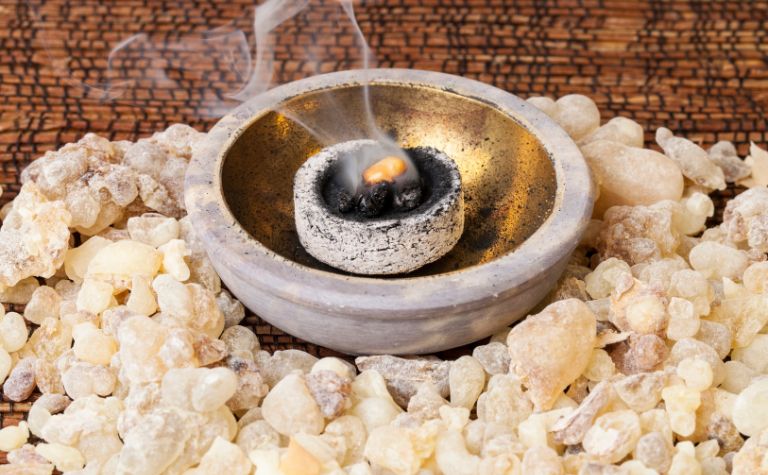Frankincense, often mentioned in the Bible, holds a special place in the annals of history and spirituality.
Extracted from the resin of the Boswellia tree, this aromatic substance was highly prized in ancient times for its fragrance and medicinal properties.
Its mention in various biblical events, from significant rituals to the gifts presented to the infant Jesus, underscores its cultural and spiritual significance.
The name itself is derived from the Old French term “franc encens,” which translates to “high-quality incense.”
This article aims to explore the role of frankincense in biblical contexts, its historical relevance, symbolic interpretations, and its enduring legacy in modern times.

Historical Significance of Frankincense
Frankincense’s historical significance transcends its mere mention in the Bible; it was deeply integrated into the cultural fabric of ancient societies.
Extracted from the Boswellia tree, found predominantly in the Arabian Peninsula, parts of Africa, and India, this resin became a highly sought-after commodity.
Its value in ancient times can be compared to that of gold or precious gems today.
Trade routes were established, particularly the Incense Route, to facilitate the transport of frankincense from producing regions to major civilizations like ancient Egypt, Greece, and Rome.
Such was the allure of its aromatic properties that frankincense found a place in royal ceremonies, burial processes, and daily rituals of purification.
In the context of the Bible, frankincense was notably used in temple ceremonies by the Israelites.
It was one of the ingredients in the sacred incense blend described in the Book of Exodus, underscoring its importance in sacred rites and its role in connecting the spiritual with the temporal.
Moreover, its place as one of the three gifts, alongside gold and myrrh, presented to the infant Jesus by the Magi accentuates its status not just as a valuable item but also as a symbol of reverence.
Throughout history, frankincense was more than just an aromatic substance; it was a symbol of esteem, purity, and spiritual connection, playing a pivotal role in the ceremonies and traditions of ancient civilizations.

Frankincense in Biblical Events
Frankincense is mentioned in various instances throughout the Bible, underscoring its prominence in ancient times. One of the most well-known appearances is in the narrative of the birth of Jesus.
As detailed in the Gospel of Matthew, the Magi, often referred to as the Wise Men, traveled to Bethlehem to pay homage to the infant Jesus.
They presented Him with three symbolic gifts: gold, frankincense, and myrrh. The frankincense, with its aromatic qualities, represented Christ’s priestly role and the spiritual significance of his birth.
Additionally, in the Old Testament, frankincense is recurrently associated with worship and the sacred rituals of the Israelites.
In the Book of Exodus, God gives Moses a precise recipe for sacred incense to be used in the tabernacle, with frankincense as a primary ingredient.
This incense was to be set before the Ark of the Covenant, signifying the prayers and supplications of the people ascending to God.
Leviticus also makes mention of frankincense in the context of grain offerings, where it was added to cakes as a pleasing aroma to the Lord.
It was also part of the thanksgiving offerings, symbolizing the heartfelt gratitude of the faithful.
Through these references, it becomes evident that frankincense held not just material but also profound symbolic value in the Biblical world.
Its repeated mention signifies its integral role in the spiritual and ceremonial practices of the time.

Symbolic Interpretations of Frankincense
Frankincense, beyond its tangible uses, carries a wealth of symbolic interpretations in the Bible.
Its aromatic nature, producing a fragrant smoke when burned, made it an ideal representation for prayer.
This is seen in several scriptures where the rising smoke of frankincense parallels the ascending prayers of the faithful toward heaven.
In the context of the gifts of the Magi to the infant Jesus, the offering of frankincense is thought to symbolize Christ’s divine nature and his role as a priest who intercedes on behalf of humanity.
The very act of giving frankincense, traditionally reserved for deities in ancient cultures, underscores the recognition of Jesus’s divine status.
Furthermore, frankincense, due to its purification qualities, is also interpreted as a symbol of holiness and righteousness.
Its inclusion in sacred rituals, as highlighted in the books of Exodus and Leviticus, emphasizes its role in setting apart objects, spaces, and occasions as special or dedicated to God.
Throughout the Bible, frankincense is consistently used to denote that which is holy, pure, and worthy of reverence.
Modern Uses and Significance
Frankincense, known for its rich history and biblical associations, continues to play a role in contemporary society.
Today, it is commonly used in the perfume and cosmetics industry due to its distinct aromatic profile.
Its resin, when distilled, produces an essential oil that is sought after for its potential therapeutic benefits.
Many believe that frankincense oil can aid in reducing stress, alleviating pain, and boosting immunity, although scientific evidence on some of these claims remains inconclusive.
Beyond its medicinal and cosmetic applications, frankincense maintains a presence in various spiritual and cultural ceremonies around the world.
Its fragrant smoke is still used in some Christian liturgical practices as a symbol of prayer and purification.
Similarly, burning frankincense is a way to cleanse spaces, mark special occasions, or foster meditation in different cultures and traditions.
Furthermore, frankincense is a subject of scientific research, with studies exploring its potential anti-inflammatory properties and other health benefits.
As these investigations progress, the ancient resin might find new applications in modern medicine.
Frankincense in Art and Literature
Frankincense, with its deep historical and cultural roots, has found its way into various art forms and literary works throughout the centuries.
In visual arts, many classical paintings depict the nativity scene, where the three Magi present gifts to the infant Jesus.
Among these gifts, frankincense is often symbolized by an ornate censer or container, emphasizing its value and importance in ancient times.
Literature, too, is no stranger to references of frankincense.
Classical poets and playwrights occasionally mention it, drawing upon its rich aromatic quality to set a scene or convey luxury.
In more modern times, authors have used frankincense as a symbol, alluding to its historical significance to convey themes of reverence, tradition, or the passage of time.
Moreover, music and song have occasionally incorporated frankincense into their lyrics or narratives.
Traditional hymns, particularly those centered around the Christmas story, might make mention of the treasured resin.
Overall, frankincense’s influence in art and literature serves as a testament to its enduring cultural significance.
Its presence in these mediums not only reminds audiences of its biblical and historical relevance but also underscores its continued resonance in contemporary expressions of creativity.
Related Questions
Joseph, the husband of Mary and the earthly father of Jesus Christ, is depicted in the Gospels as humble, law-abiding, and obedient. In many Christmas scenes, such as in displays of the manger, he is...
The virgin Mary, the mother of Jesus, is one of the most fascinating people in the Bible. For 2,000 years, people of different eras and cultures have marveled at her faith in God. Mary's story in the...
